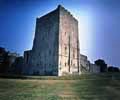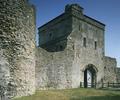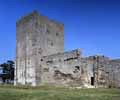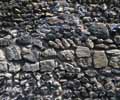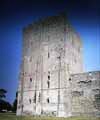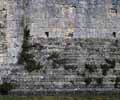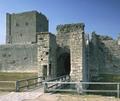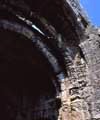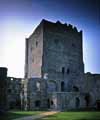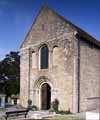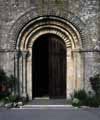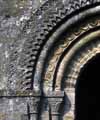Portchester
Hampshire
The ruined castle that stands before us today was originally built within the 3rd century Roman fort, Portrus Adorni, which use to protect ships at anchor. It formed part of a series of strategically sited forts protecting harbours from here, in the south, to the Wash over on the east coast,
as defence against Saxon and Frankish raiders.
In 904 it passed to the Saxon King, Edward the Elder and a hundred and eighty two years later years, William the Conqueror granted the land to one of his supporters,
William Mauduit who may have been his Chamberlain.
After the mysterious death in the New Forest of King William II (Rufus) on the 2nd August 1100, his young brother Henry seized the English throne, three days later, from his elder brother, Duke Robert of Normandy who had not returned from Crusade.
Robert de Bellême, probably standing in front of his troops on the seaward side of Portchester fortress, greeted the Duke and his invasion fleet on the 21st July 1101. Together with their armies they marched to Alton to do battle against Henry. Against the advice of Robert de Bellême the Duke signed away his entitlement to the English throne for peace and an annual pension of 3,000 marks.
Approximately 1120 the stone keep was built but the first recorded entry, for any building and costs, was for the year 1173 when £2 and £9 were spent on repairs to the keep, gates and walls.
Elias l’ingeniator (engineer/architect) was in charge of the King’s works in 1192 but the work was unspecified. Later in that year Elias was still in charge of building work, which now included the readying of mangonels (stone throwing machines) at a cost of £10.13.2d.
After the death of King Richard (Lionheart) in 1199, King John continued to keep it in good repair as Portchester was one of his favourite lodges, having easy access to the hunting in the Forest of Bere.
In 1216 it was besieged and captured by the French but was soon returned to English control.
It was probably during the 1250’s that King Henry III sent his royal mason, John of Gloucester to be in charge of the works at Portchester and it seems that he was responsible for heightening of the keep by two floors. As a royal mason he received one shilling per day plus a summer and a winter robe yearly.
Over the years the castle was kept in good condition and when Richard II came to the throne he was moved to have new buildings and repairs speedily done, 280 men were employed under the charge of one of the great craftsmen of the 14th century, Henry Yeveley, the King’s master mason. The work covered the period from about, 1381 to 1397 and the building costs involved were said to be in the region of £1, 700. The men also had to work at night with the aid of candlelight. It must have presented an amazing scene, with hammering and sawing midst a landscape of hundreds lights.
Forty four years later in the reign of King Henry VI it was reported that the castle be,
“right ruynouse and fieble.”
And in 1450 the Constable of the castle, Robert Fienys wrote to the King describing, “the greet ruyne decay and delapidaticion of your castel at Portchestre”. complaining that, “the gatez ben broken and avoided bothe within and withoute, the draghtbrugge (before the) gatehous, the wall beth fallen downe and other houses of office in default of reparacion and oversight (faile) sore bothe in their rofez and in flores”.
Sadly nothing was done as the castle had lost its military importance.
By 1495 during the reign of King Henry VII the decision was made to move the fleet away, to the mouth of the harbour at Portsmouth.
It is now in the care of English Heritage and is open to the public.
English &Welsh Castle Picture Search Results
Your Search returned 12 pictures.
Click on a picture to enlarge and order
